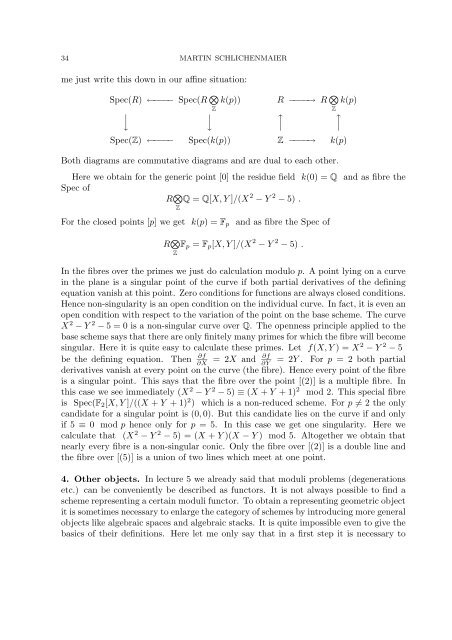Mannheimer Manuskripte 177 gk-mp-9403/3 SOME CONCEPTS OF ...
Mannheimer Manuskripte 177 gk-mp-9403/3 SOME CONCEPTS OF ...
Mannheimer Manuskripte 177 gk-mp-9403/3 SOME CONCEPTS OF ...
- No tags were found...
Create successful ePaper yourself
Turn your PDF publications into a flip-book with our unique Google optimized e-Paper software.
34 MARTIN SCHLICHENMAIERme just write this down in our affine situation:Spec(R) ←−−−− Spec(R ⊗ Z⏐⏐↓↓k(p))R −−−−→ R ⊗ k(p)Z↑ ↑⏐ ⏐Spec(Z) ←−−−− Spec(k(p)) Z −−−−→ k(p)Both diagrams are commutative diagrams and are dual to each other.Here we obtain for the generic point [0] the residue field k(0) = Q and as fibre theSpec ofR ⊗ ZQ = Q[X,Y ]/(X 2 − Y 2 − 5) .For the closed points [p] we get k(p) = F pand as fibre the Spec ofR ⊗ F p = F p [X,Y ]/(X 2 − Y 2 − 5) .ZIn the fibres over the primes we just do calculation modulo p. A point lying on a curvein the plane is a singular point of the curve if both partial derivatives of the definingequation vanish at this point. Zero conditions for functions are always closed conditions.Hence non-singularity is an open condition on the individual curve. In fact, it is even anopen condition with respect to the variation of the point on the base scheme. The curveX 2 − Y 2 − 5 = 0 is a non-singular curve over Q. The openness principle applied to thebase scheme says that there are only finitely many primes for which the fibre will becomesingular. Here it is quite easy to calculate these primes. Let f(X,Y ) = X 2 − Y 2 − 5be the defining equation. Then ∂f∂f∂X= 2X and∂Y= 2Y . For p = 2 both partialderivatives vanish at every point on the curve (the fibre). Hence every point of the fibreis a singular point. This says that the fibre over the point [(2)] is a multiple fibre. Inthis case we see immediately (X 2 − Y 2 − 5) ≡ (X + Y + 1) 2 mod 2. This special fibreis Spec(F 2 [X,Y ]/((X + Y + 1) 2 ) which is a non-reduced scheme. For p ≠ 2 the onlycandidate for a singular point is (0,0). But this candidate lies on the curve if and onlyif 5 ≡ 0 mod p hence only for p = 5. In this case we get one singularity. Here wecalculate that (X 2 − Y 2 − 5) = (X + Y )(X − Y ) mod 5. Altogether we obtain thatnearly every fibre is a non-singular conic. Only the fibre over [(2)] is a double line andthe fibre over [(5)] is a union of two lines which meet at one point.4. Other objects. In lecture 5 we already said that moduli problems (degenerationsetc.) can be conveniently be described as functors. It is not always possible to find ascheme representing a certain moduli functor. To obtain a representing geometric objectit is sometimes necessary to enlarge the category of schemes by introducing more generalobjects like algebraic spaces and algebraic stacks. It is quite i<strong>mp</strong>ossible even to give thebasics of their definitions. Here let me only say that in a first step it is necessary to
















